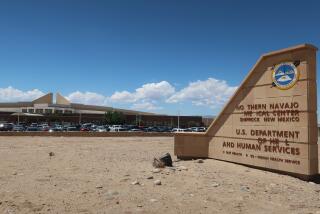Bright Ideas Bring Light to Hinterlands : Engineers have devised solar power systems for far corners of the Navajo reservation and isolated villages in Alaska.
- Share via
Despite the trend toward urbanization in the United States, some areas remain so remote from utilities that even turning on a light has not been possible.
But from the sprawling Navajo reservation in the Southwest to isolated villages in Alaska, technology is coming to the rescue, providing electricity to some of the most impoverished areas in the country for the first time.
These are regions so far from generating facilities or so lightly populated that it has not been profitable to build power lines to supply the electricity that city dwellers take for granted. But now, electrical engineers at Sandia National Laboratories in Albuquerque are building systems that will supply electricity to even the most remote homes.
To do it, they are using the latest technology to harness the oldest source of energy: the power of the sun.
The Navajo reservation, sprawling over 17 million acres in Arizona, New Mexico and Utah, is home to about 175,000 people, about a third of whom have no electricity.
Indians on the far reaches of the reservation have tried to make do with whatever they could find, including solar power systems that are difficult to maintain and often inadequate.
Earlier, Sandia set up photovoltaic systems for about 300 households, but without proper maintenance, the systems deteriorated.
Last year, the federal Energy Department entered into a contract with the Navajo Tribal Utility Authority, which provides electricity for the reservation, to develop a properly maintained solar power system. The program initially will serve 60 to 80 homes, but officials hope eventually to serve the needs of about 10,000 families.
Photovoltaic generators to convert sunlight into electricity will be installed at the first sites later this summer. The utility will own the systems, and homeowners will pay a monthly rate estimated at $20 to $50.
“What’s different here is we are setting up an infrastructure that will service and maintain the systems,” project manager Roger Hill said.
The solar collectors, which are particularly useful in the hot, sunny Southwest, will charge batteries that will supply electricity even after the sun goes down. Hill said the service will not be comparable to that available in urban areas, but it will be enough to run lights and a few small appliances.
He said the goal is to add propane generators to augment the solar power system so that the batteries can be charged even during rainy weather.
If the program works as well as Sandia officials hope, it will become the largest residential solar power system in the country.
It remains to be seen, however, just how many of the families can afford to join in the program, Hill said. For many residents of the reservation, paychecks are even scarcer than electricity.
In the Alaskan village of Wales, there is not always enough sunlight to keep batteries charged, but Hill’s colleagues at Sandia have come up with a three-part hybrid system to supply electricity there.
Wales, a tiny fishing community on the western tip of the Seward Peninsula, just south of the Arctic Circle, is on a wind-swept point that juts into the Bering Strait.
Electricity is now produced there by diesel generators. The fuel can be shipped in only during the summer.
Wales is in the land of the midnight sun, so it has an abundant solar energy during the summer, but weeks of darkness during the winter, when winds whip across the barren tundra.
The system designed by Sandia’s Russell Bonn will use solar collectors during the summer. A large windmill, similar to the big turbines that dot the desert floor near Palm Springs, will tap the winds during the winter.
Both the windmill and the collectors will charge a large bank of batteries. The diesel generators will charge the batteries when all else fails.
“All three can play together,” Bonn said.
More to Read
Sign up for Essential California
The most important California stories and recommendations in your inbox every morning.
You may occasionally receive promotional content from the Los Angeles Times.










